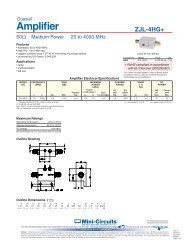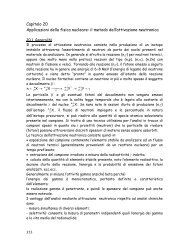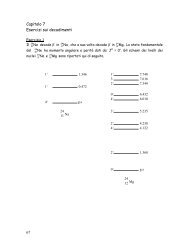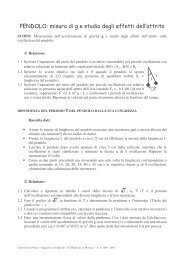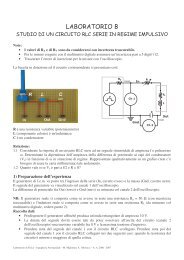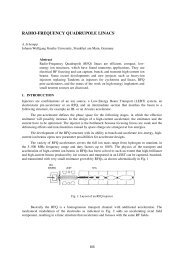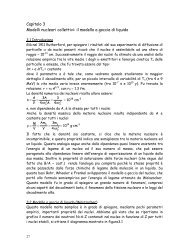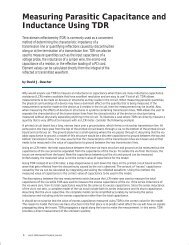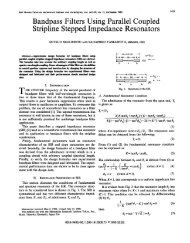244 Capitolo 17 I rivelatori di particelle
244 Capitolo 17 I rivelatori di particelle
244 Capitolo 17 I rivelatori di particelle
You also want an ePaper? Increase the reach of your titles
YUMPU automatically turns print PDFs into web optimized ePapers that Google loves.
dove x rappresenta lo spessore effettivo <strong>di</strong> rivelatore “visto” dalla ra<strong>di</strong>azione (ve<strong>di</strong><br />
fig. <strong>17</strong>.8) e λ il libero cammino me<strong>di</strong>o all’interno del rivelatore.<br />
Nel caso <strong>di</strong> fotoni λ = 1/µ , mentre nel caso <strong>di</strong> <strong>particelle</strong> cariche il valore <strong>di</strong> λ è<br />
confrontabile con le <strong>di</strong>stanze interatomiche, cosicché p int = 1.<br />
L’efficienza totale può essere fattorizzata in due termini: l’efficienze intrinseca e<br />
l’efficienze geometrica o accettanza: ε tot = ε intr ⋅ ε geom<br />
L’efficienza intrinseca rappresenta quin<strong>di</strong> la frazione <strong>di</strong> eventi registrati tra quelli<br />
che sono <strong>di</strong>retti nel rivelatore.. L’efficienze intrinseca è ovviamente una funzione<br />
del tipo <strong>di</strong> ra<strong>di</strong>azione, della sua energia e del tipo <strong>di</strong> materiale <strong>di</strong> cui è composto il<br />
rivelatore.<br />
<strong>17</strong>.6 Tempo morto<br />
La registrazione <strong>di</strong> un evento richiede un certo tempo e il rivelatore rimane<br />
insensibile per questo tempo, detto tempo morto. Se un secondo evento non <strong>di</strong>sta<br />
temporalmente dal primo per più del tempo morto, non viene registrato. E’ evidente<br />
che se siamo interessati ad una qualsiasi misura <strong>di</strong> intensità <strong>di</strong> ra<strong>di</strong>azione è<br />
importante conoscere il tempo morto per poter correggere opportunamente la<br />
misura.<br />
1<br />
2<br />
3<br />
4<br />
5<br />
6<br />
7<br />
τ τ τ τ τ<br />
Fig. <strong>17</strong>.9 visualizzazione del tempo morto <strong>di</strong> un rivelatore<br />
Nell’esempio riportato in figura <strong>17</strong>.9 gli eventi numero 4 e 6 non sono registrati.<br />
Supponiamo che in una misura durata un tempo complessivo T siano stati registrati<br />
k conteggi. Se il tempo morto del rivelatore è τ, l’intensità <strong>di</strong> conteggi corretta m è<br />
data da:<br />
mT = k + m⋅k⋅τ<br />
infatti k rappresenta il numero <strong>di</strong> conteggi rivelati e k⋅τ il tempo totale durante il<br />
quale il rivelatore è rimasto insensibile: poiché l’intensità vera <strong>di</strong> conteggi è m, nel<br />
tempo k⋅τ il numero <strong>di</strong> conteggi persi è m⋅k⋅τ . Risolvendo:<br />
k<br />
m =<br />
T<br />
k<br />
1 − τ<br />
T<br />
250




